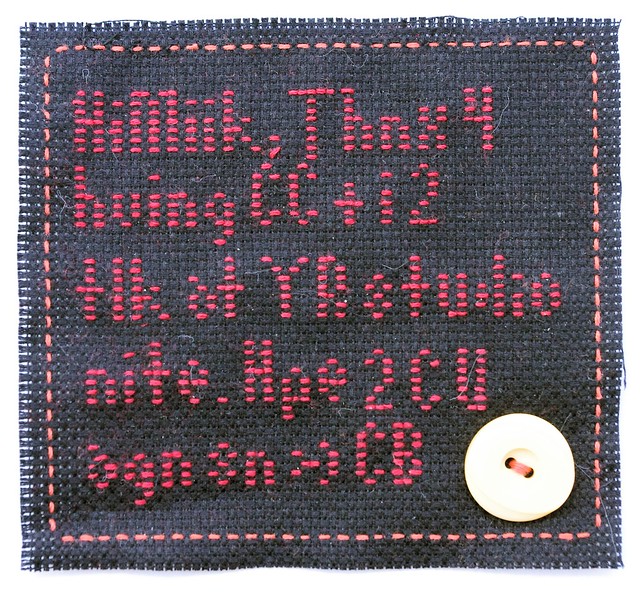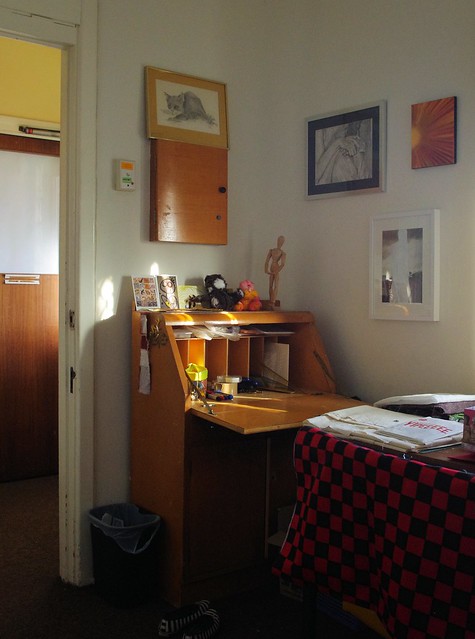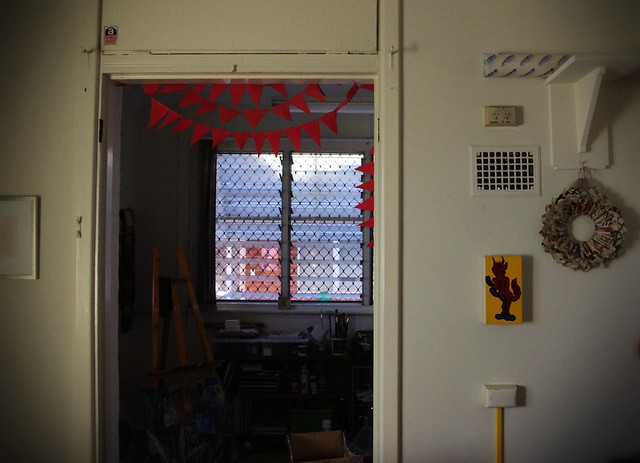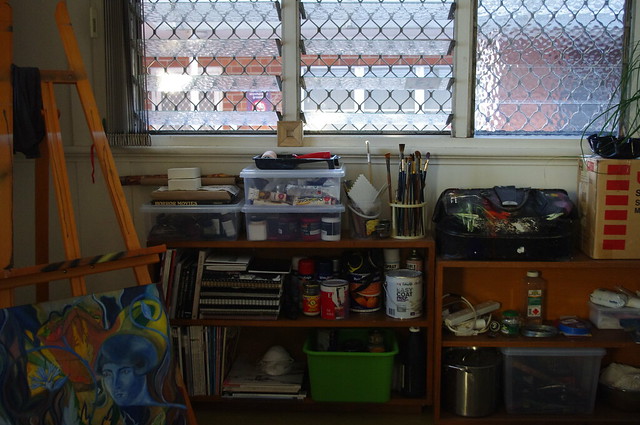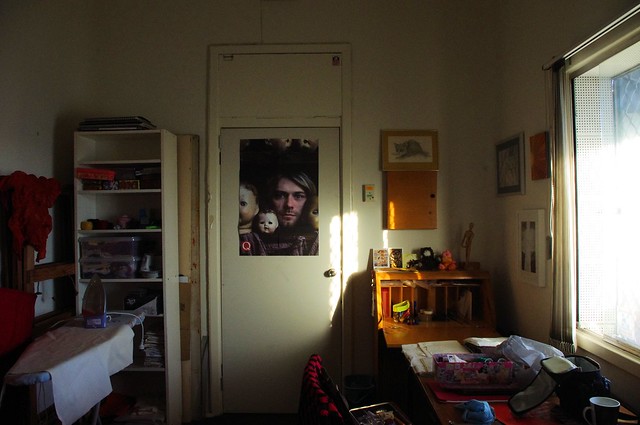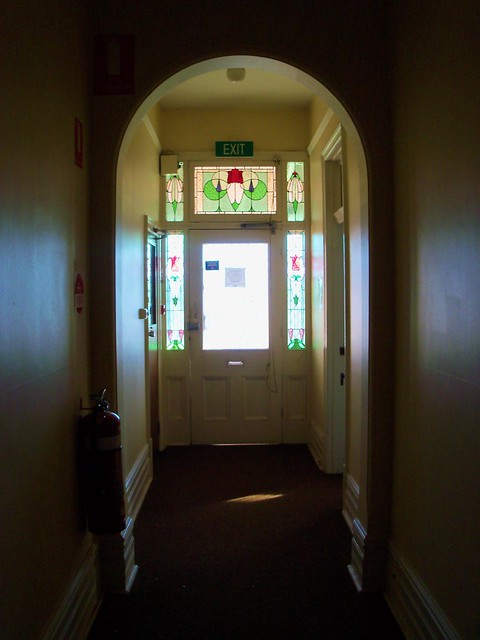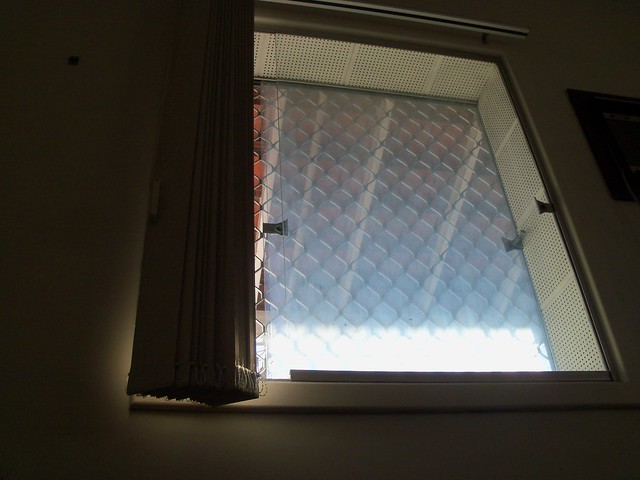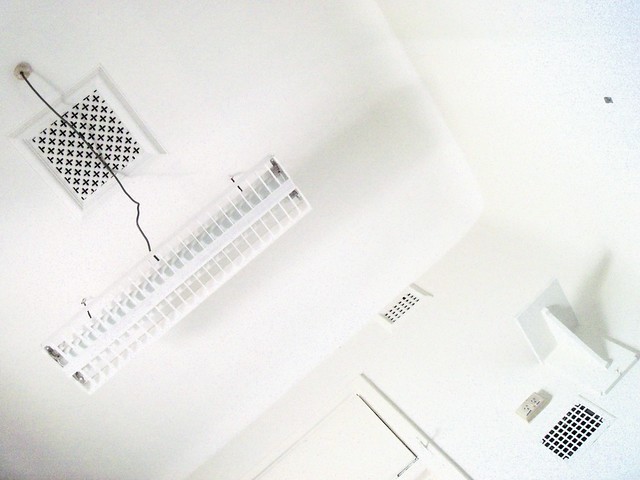Saturday, March 17, 2012
Thursday, March 15, 2012
A thankyou
This is little thanks I mailed to Miik Green for having Claire² to speak at his studio night last week. We felt rather honored to talk about our Claire² projects in this forum. It was also great to hear some thoughts and feedback too, many thanks to everyone who came along.
Saturday, March 3, 2012
Speaking with Maria Hildrick
The first time I met Maria was at an exhibition opening at The Oats Factory. I got talking to this rad lass and when I realised who she was I got a little excited, blurting something like, "oh my god your Maria Hildrick! I love your work" in a gushing way I seem to be prone to upon meeting people I've been admiring. Luckily for me she's good humoured and didn't run away. Instead we became friends and exhibited together last year in Beast for Thee. For March Speaking with she has graciously spent some time talking to me about her work.
Can you tell us a little about your background? Where did you grow up and where did you study?
I grew up mostly in and around Dublin, Ireland, spending a couple of years in England too. We moved a lot when I was little, I'd been to about 20 schools and lived in 30 different homes by the time I was 13. Moving home so frequently instilled my love of objects and the values we place on them. Also, pretty much all of our belongings came from second hand shops and this brought about a fascination with the history of objects, from op shops or the side of the street. Both my parents were very creative people so my sisters and I grew up surrounded by imagination, music and play. Painting and drawing have been a part of my life for as long as I can remember and it was one of the things I most enjoyed as a kid.
My Mum Eileen developed schizophrenia when I was about 7 and this intensified and softened in varying amounts until her death 10 years later. Witnessing and reacting to these times, as part of my family and as an individual, is another aspect of my history that imparts heavily on my work.
I didn't sit the whole of my Leaving Cert (exams at the end of high school), only attending the Art and the English exam as these were the ones that I felt were important to me! I wasn't sure what I wanted to do with my self at that time really... I did a portfolio preparation course for a year and was lucky as the following year art colleges weren't only accepting students with enough Leaving Cert points anymore. They now accepted the cert I received from the portfolio course for entry to the college, along with a portfolio.
I started a degree in fine art at The National College of Art & Design in 2002. In the first year you got to play with everything before choosing what area you wished to specialise in. I did consider print, and enjoyed sculpture too but in the end decided on painting. The creative energy and location were amazing and really stimulating. There was a real emphasis on learning how to look, developing an awareness of ideas and how your work can be interpreted. I almost didn't realise how much I was learning and developing. I can really see the evolution of my current style from those years, particularly from the final two years, where my mixing of graphite, ink and oil began... I graduated in 2006 with a BA Fine Art, Painting and had my first solo show the following year. A few months later I left Ireland to travel and eventually found my way here to Perth.
Do you think that the move to Perth, it's landscape (physical and/or cultural) have influenced your work in any ways that are particular to being here, in this place, at this time?
The physical landscape has certainly influenced me. It really is vastly different to where I come from; the colours, the trees and plants, the wildlife, the light, the earth. I derive so much from nature and my surroundings that it couldn’t but permeate my work. Insects in particular have featured, at home too, but now to an even greater extent. In Ireland I used to work at a grain intake during the summer holidays and with the samples of barley would come the body of a earwig or a moth’s wing. Ladybirds caught by the combine mid flight were particularly treasured. The creatures I find here in Australia amaze me. I get very excited when I find a sand-groper who’s time has come or a stink bug who’s bitten the big one. One of the best is a praying mantis I found squished in Coral Bay.
There is an area of bush across from my house and it’s full of kookaburras, owls and magpies. Bobtail lizards too, who like to hang out in our garden sometimes. There is so much green space in Perth, so much wild life in the suburbs, that to be here now means a great deal to me as the city is growing so much. The bush land in front of my house has been sold and they are going to develop it into something like 50 apartments...
Also, coming to Perth and being so far away from everything I knew led me to explore objects in a different light. The verge side collection has been a great source of material for me and most of our house is furnished off the side of the street. My house-mates came home one day with a box full of carefully packaged ornaments; a ceramic cat, a little koala. These found objects, obviously once loved as they were remarkably well wrapped just to be chucked out, came to feature in much of my early work here in Australia. In the paintings they are searching for a place amongst imagery from my past. It wasn't until later that I realised this echoed how I too was searching for a place for myself. These pieces, once strangers and with their own history, have now come to mean a great deal to me. They are symbols of this place and that time. The other day I dropped the box they live in and let out a wail of devastation as I heard the sound of shattering from within! Fortunately none of the ones I use in my work were broken. It’s funny though, how the attachment develops. Coming here with just a backpack meant I was sort of starting from scratch in regards to objects with meaning and history. I now have a collection of objects that carry as much memory for me as the bench or the willow pattern plates from home.
Are you working on something at the moment that you can tell us about?
At the moment I’m trying to figure out what I think about the form of an echo! I’m going to be doing a project with a WA arts magazine called dot dot dash and they are going to pair me up with a writer to collaborate on a piece. The brief is entitled the form of an echo and takes a passage from a talk by Derrida where he explores the story of Echo and Narcissus. I haven’t met my writer yet so at the moment I’m just spending time trying to figure out what I think and find a way into the subject matter, figure out my own thoughts...
Coming back to your use of insects and found objects, I can relate well to your attraction to these things and have used them in my own work. For me the "used" holds a kind of life via transference. Like as though along with our fingerprints, we leave bits of energy behind. And the little empty bodies of insects and small creatures make me think about what we overlook, little receptacles of “once was”. Do you have any thoughts on this and what attracts you to the found?
I feel the same way, the insects are fragments of being, some are whole, some broken. Others have been hollowed from the inside out so all that’s left is their shell. They certainly carry the notion of “once was”, similar in a way to found objects and the history they carry.
I have collected a couple of bobtails too that were squished and dried out in the sun so just their skin is left preserved, their little legs caught mid run. I also found a small kangaroo paw and forearm recently. It was funny, initially I didn’t keep the paw, the leap to mammals seemed too great! I ended up going back for it the next day though… There is something about the bobtails in particular that resonates with being overlooked for me. I often see them on the side of the road. When they’re run over all their insides come out of their mouth because their skins are so tough. Their mouths are wide open, all the life rushing out of them… I guess they are such an every day thing for most people here that they don’t really register...
There are objects all over the world at this stage that I have lost or left behind. It’s interesting to me to think of these things and wonder where they are existing now, are they alone or part of someone else’s life. One of the things I love so much about the found is how it comes into your life, that you’ve happened upon this object because you went down that road, it’s that chance meeting. It’s kind of like that with people too sometimes.
The idea of leaving a type of fingerprint behind is lovely, makes me think of when I was little; my parents let us draw on the walls of the flats we lived in and when we moved on Johnny would repaint them. Under layers of paint in flats all over Dublin and London are little creatures and castles and lines and circles covered by more and more layers as other people lived there and moved on.
I love that idea of drawing on the walls of a home, another artist I interviewed last year, Lorraine Corker has a similar childhood story of drawing and writing on walls before covering it with fresh wallpaper. I've moved alot myself and find the idea of leaving a mark like this fascinating because I've never been able to feel connected to a "home" as such. Bricks and mortar seem so temporary to me and I suppose I like the fact that this drawing on the walls kind of celebrates an ephemeral notion of home.
The sense of home is so subjective. I was at a exhibition last year, photographers were paired up with young homeless people to help them capture their notion of home on film. It was such a moving exhibit, images of stairwells and car parks, derelict houses and bushes; all these places, so out of sync with the mainstream notion of home, were home for these people. There was one girl who was no longer homeless and she took photos of the little porcelain creatures she collects. Just being able to have somewhere to put an object meant a tremendous amount to her and so the objects themselves came to carry that significance too...
Are there any books or movies that have significantly influenced your work?
What comes to the forefront of my mind is Jan Švankmajer’s Alice, a reworking of Alice in Wonderland, in which he explores the darker aspects of the story using a mixture of live action and stop motion animation. Švankmajer uses bird, reptile and amphibian skeletons, stuffed animals and tongues, eyeballs and various organs to create the characters Alice interacts with. I first saw this as a child and was absorbed by it’s eerie, nightmarish qualities and particularly the use of animal parts, something that has permeated my own work as an adult.
Honesty in work is something I value, laying yourself bare. Hunter S Thompson's writing is influential for his raw and uncompromising accounts of experience, as is Charles Bukowski. It’s not so much a direct influence on actual paintings as it is on the integrity of my work I guess... I’m always honest to the times and emotions I draw on for my paintings. I rarely deviate from the original image and leave exposed my own personal experiences of transience, mental illness, suicide, love...
Where can people find out more about your work?
People can find out more about my work and dates of upcoming shows at www.mariahildrick.com. We will be adding a mailing list soon too so keep your eyes peeled!
 |
| Eileen felt her own absence, Maria Hildrick, 2010. Oil, graphite and ink on canvas. |
Can you tell us a little about your background? Where did you grow up and where did you study?
I grew up mostly in and around Dublin, Ireland, spending a couple of years in England too. We moved a lot when I was little, I'd been to about 20 schools and lived in 30 different homes by the time I was 13. Moving home so frequently instilled my love of objects and the values we place on them. Also, pretty much all of our belongings came from second hand shops and this brought about a fascination with the history of objects, from op shops or the side of the street. Both my parents were very creative people so my sisters and I grew up surrounded by imagination, music and play. Painting and drawing have been a part of my life for as long as I can remember and it was one of the things I most enjoyed as a kid.
My Mum Eileen developed schizophrenia when I was about 7 and this intensified and softened in varying amounts until her death 10 years later. Witnessing and reacting to these times, as part of my family and as an individual, is another aspect of my history that imparts heavily on my work.
I didn't sit the whole of my Leaving Cert (exams at the end of high school), only attending the Art and the English exam as these were the ones that I felt were important to me! I wasn't sure what I wanted to do with my self at that time really... I did a portfolio preparation course for a year and was lucky as the following year art colleges weren't only accepting students with enough Leaving Cert points anymore. They now accepted the cert I received from the portfolio course for entry to the college, along with a portfolio.
I started a degree in fine art at The National College of Art & Design in 2002. In the first year you got to play with everything before choosing what area you wished to specialise in. I did consider print, and enjoyed sculpture too but in the end decided on painting. The creative energy and location were amazing and really stimulating. There was a real emphasis on learning how to look, developing an awareness of ideas and how your work can be interpreted. I almost didn't realise how much I was learning and developing. I can really see the evolution of my current style from those years, particularly from the final two years, where my mixing of graphite, ink and oil began... I graduated in 2006 with a BA Fine Art, Painting and had my first solo show the following year. A few months later I left Ireland to travel and eventually found my way here to Perth.
 |
| Sandgroper enjoys feather, Maria Hildrick, 2010. |
Do you think that the move to Perth, it's landscape (physical and/or cultural) have influenced your work in any ways that are particular to being here, in this place, at this time?
The physical landscape has certainly influenced me. It really is vastly different to where I come from; the colours, the trees and plants, the wildlife, the light, the earth. I derive so much from nature and my surroundings that it couldn’t but permeate my work. Insects in particular have featured, at home too, but now to an even greater extent. In Ireland I used to work at a grain intake during the summer holidays and with the samples of barley would come the body of a earwig or a moth’s wing. Ladybirds caught by the combine mid flight were particularly treasured. The creatures I find here in Australia amaze me. I get very excited when I find a sand-groper who’s time has come or a stink bug who’s bitten the big one. One of the best is a praying mantis I found squished in Coral Bay.
There is an area of bush across from my house and it’s full of kookaburras, owls and magpies. Bobtail lizards too, who like to hang out in our garden sometimes. There is so much green space in Perth, so much wild life in the suburbs, that to be here now means a great deal to me as the city is growing so much. The bush land in front of my house has been sold and they are going to develop it into something like 50 apartments...
Also, coming to Perth and being so far away from everything I knew led me to explore objects in a different light. The verge side collection has been a great source of material for me and most of our house is furnished off the side of the street. My house-mates came home one day with a box full of carefully packaged ornaments; a ceramic cat, a little koala. These found objects, obviously once loved as they were remarkably well wrapped just to be chucked out, came to feature in much of my early work here in Australia. In the paintings they are searching for a place amongst imagery from my past. It wasn't until later that I realised this echoed how I too was searching for a place for myself. These pieces, once strangers and with their own history, have now come to mean a great deal to me. They are symbols of this place and that time. The other day I dropped the box they live in and let out a wail of devastation as I heard the sound of shattering from within! Fortunately none of the ones I use in my work were broken. It’s funny though, how the attachment develops. Coming here with just a backpack meant I was sort of starting from scratch in regards to objects with meaning and history. I now have a collection of objects that carry as much memory for me as the bench or the willow pattern plates from home.
Are you working on something at the moment that you can tell us about?
At the moment I’m trying to figure out what I think about the form of an echo! I’m going to be doing a project with a WA arts magazine called dot dot dash and they are going to pair me up with a writer to collaborate on a piece. The brief is entitled the form of an echo and takes a passage from a talk by Derrida where he explores the story of Echo and Narcissus. I haven’t met my writer yet so at the moment I’m just spending time trying to figure out what I think and find a way into the subject matter, figure out my own thoughts...
 |
| Fish funeral II, Maria Hildrick, watercolour on paper. |
Coming back to your use of insects and found objects, I can relate well to your attraction to these things and have used them in my own work. For me the "used" holds a kind of life via transference. Like as though along with our fingerprints, we leave bits of energy behind. And the little empty bodies of insects and small creatures make me think about what we overlook, little receptacles of “once was”. Do you have any thoughts on this and what attracts you to the found?
I feel the same way, the insects are fragments of being, some are whole, some broken. Others have been hollowed from the inside out so all that’s left is their shell. They certainly carry the notion of “once was”, similar in a way to found objects and the history they carry.
I have collected a couple of bobtails too that were squished and dried out in the sun so just their skin is left preserved, their little legs caught mid run. I also found a small kangaroo paw and forearm recently. It was funny, initially I didn’t keep the paw, the leap to mammals seemed too great! I ended up going back for it the next day though… There is something about the bobtails in particular that resonates with being overlooked for me. I often see them on the side of the road. When they’re run over all their insides come out of their mouth because their skins are so tough. Their mouths are wide open, all the life rushing out of them… I guess they are such an every day thing for most people here that they don’t really register...
There are objects all over the world at this stage that I have lost or left behind. It’s interesting to me to think of these things and wonder where they are existing now, are they alone or part of someone else’s life. One of the things I love so much about the found is how it comes into your life, that you’ve happened upon this object because you went down that road, it’s that chance meeting. It’s kind of like that with people too sometimes.
The idea of leaving a type of fingerprint behind is lovely, makes me think of when I was little; my parents let us draw on the walls of the flats we lived in and when we moved on Johnny would repaint them. Under layers of paint in flats all over Dublin and London are little creatures and castles and lines and circles covered by more and more layers as other people lived there and moved on.
 |
| Wasp - 3D ink drawing, Maria Hildrick, 2010. Paper mache, wire, ink & plastic. |
The sense of home is so subjective. I was at a exhibition last year, photographers were paired up with young homeless people to help them capture their notion of home on film. It was such a moving exhibit, images of stairwells and car parks, derelict houses and bushes; all these places, so out of sync with the mainstream notion of home, were home for these people. There was one girl who was no longer homeless and she took photos of the little porcelain creatures she collects. Just being able to have somewhere to put an object meant a tremendous amount to her and so the objects themselves came to carry that significance too...
,+2011.+Oil+and+graphite+on+canvas,+20+x+24+inches+.jpg) |
| Stereotypy I (Eileen), Maria Hildrick, 2011. Oil and graphite on canvas. |
Are there any books or movies that have significantly influenced your work?
What comes to the forefront of my mind is Jan Švankmajer’s Alice, a reworking of Alice in Wonderland, in which he explores the darker aspects of the story using a mixture of live action and stop motion animation. Švankmajer uses bird, reptile and amphibian skeletons, stuffed animals and tongues, eyeballs and various organs to create the characters Alice interacts with. I first saw this as a child and was absorbed by it’s eerie, nightmarish qualities and particularly the use of animal parts, something that has permeated my own work as an adult.
Honesty in work is something I value, laying yourself bare. Hunter S Thompson's writing is influential for his raw and uncompromising accounts of experience, as is Charles Bukowski. It’s not so much a direct influence on actual paintings as it is on the integrity of my work I guess... I’m always honest to the times and emotions I draw on for my paintings. I rarely deviate from the original image and leave exposed my own personal experiences of transience, mental illness, suicide, love...
Where can people find out more about your work?
People can find out more about my work and dates of upcoming shows at www.mariahildrick.com. We will be adding a mailing list soon too so keep your eyes peeled!
Thursday, March 1, 2012
In my new studio
All moved in, still a little unpacking and decorating to do but pretty much feeling at home there now.
Monday, February 20, 2012
Ends and Beginnings
This month I've been busily packing my studio in Midland and moving it all to my new studio in Leederville. It is a little sad to say goodbye to Midland, my first 'real' studio, and the room where I've been creating work for almost two years.
It's been a ritual of mine to take one photograph of the town hall across the road, the view from my window, as the first thing I did each time I entered the room. I took my last photo on Saturday and felt a pang of sadness when I realised this was goodbye. I feel very grateful for the time spent in that room looking across at that clock who seemed such a friendly face keeping me company.
I've documented my view from the Midland studio window at viewfromawindowproject.tumblr.com.
But with one ending comes two new beginnings. My new studio in Leederville is in a building called The Ward, plus I will also be embarking on a Masters degree starting from next week.
The Ward is a former maternity hospital and is an interesting building, my room has no corners - I mean the corners are all rounded instead of squared! There will be a diverse range of creatives working from this place and I am very excited to be part of the first wave of artists moving in to The Ward.
Here are a few pictures.
.
Posted by
Unknown
at
2:53 PM
Labels:
CB,
Masters work,
Midland,
my studio,
Photographs,
The Ward
1 comments


Wednesday, February 15, 2012
Speaking with Denise Brown

 Can you tell us a bit about your background, where you grew up and where you studied art?
Can you tell us a bit about your background, where you grew up and where you studied art?I grew up in Hawkesbury Upton, the highest village in the Cotswold Hills in South-West England, rich in Roman and Saxon settlements. Not much further afield are areas known for their ancient “land art”; the White Horse, Stonehenge, Avebury Stone Circle and Silbury Hill amongst many others. It is old country and a place bearing the layered histories of a long series of peoples.
Growing up in these surroundings, you become aware of the tides of change which constantly wash over human societies with the passage of time and the influx of new cultures. Living amongst such evidence of change brings home the importance of adaptability to the ever-changing “now”. It has led me to be flexible in my use of styles and media to suit my current concept.
My family were artisans and something of “outsiders” and so I was taught from an early age to be honest and to always strive to achieve one’s best because self belief is vitally important when society as a whole regards you with suspicion. The small, self contained world of the minority has little room for passengers. One needs to be both self-sufficient and beyond suspicion to achieve acceptance beyond the grudging.
I first studied art at Bristol Polytechnic, moving on to achieve a BA (Hons) in Three Dimensional Design, Wood, Metal, Ceramics and Glass at The Metropolitan University of Manchester. My experience during my course at Manchester has been fundamental to my understanding of materials and their properties and potential, leading to a broad ability to bring together apparently contradictory media such as the 3D pieces from my Emotional Tides series made from hand carved marble and fabricated steel.
Following my Degree my art practice evolved into working as a goldsmith during the evenings whilst earning a steady income as a patternmaker in industry. This industrial experience has been invaluable in enabling me to work on numerous projects and concepts simultaneously and to stringent deadlines.
Some years after migrating to Western Australia I enrolled in the Advanced Diploma in Applied Environmental Art and Design at the then Swan TAFE, graduating in 2009. During the course I was privileged to be mentored by such established artists as Peter Dailey, Stuart Elliot, Mary Dunin and others. Both my 2D work and my conceptual skills developed extensively during this period, as a result of the many positive influences.
Tell us a little about the kind of work you make?
I tend to work in series and multiples, conceptually built from my interest in the human psyche; the way we mentally interact with each other and the world around us; our ability to manipulate what our senses receive into information more palatable to our own ideas and logic centres, no matter how far stretched from reality that it may become.
I like to work on multiple concepts simultaneously. I try to achieve a spread of projects with at least one under way which has been fully developed conceptually, requiring only the physical manifestation of the works, balancing this with others where I am not fully in control of the outcomes, letting the concept lead me where it will. Others may spend years or even decades in gestation at a conceptual stage, requiring repeated reformulation. These tend to develop in quantum leaps, usually when I am engaged in other works of a repetitive nature allowing my mind to wander in sometimes unfamiliar territory.
You seem to work in a range of mediums, what is your favourite? And are there any you haven’t tried yet that you would like to?
 |
| Emotional Tides, Denise Brown. |
I do have favourite techniques however. I do like to carve. I find the act of carving in any medium relaxing and mediative. I also like to work on a medium to large scale because it is a physically more holistic experience and one can lose oneself in the action of making.
I also thoroughly enjoy the interaction needed to successfully work in oils; the ability to manipulate and play with the material and the variety of application techniques that one can develop. The whole experience is very tactile. Even the smell is intoxicating.
What are you working on at the moment?
I tend to work on half a dozen series at a time which all feed off each other in one way or another, this also allows me to change between mediums and keep interested and focused.
At the moment I am developing several bodies of work. One is all sculptural series for a solo exhibition in July this year at the Heathcote Museum & Gallery in Melville. The concept explores my early experiences as a dyslexic in a world that did not, at the time, widely recognise or acknowledge the condition, and examines the “outsideness” arising from the inability to communicate, whether as a result of a physiological condition (a lack of specific synaptic development) or that arising from cultural and linguistic differences within a migrant society such as Australia.
I am also working on a series of large paintings in oil depicting the figure and representing that figure’s personal history and psychology through the surrounding imagery. I see these works as being a development of portraiture but on a deeper emotional level than mere superficial likeness.
In addition, there is a series of ceramic sculptures concerned with the need for the primitive in the technical age and its manifestations and a further series of sculptures and oil and drawing works concerned with the mind in a state of coma.
 |
| Soft Power, Denise Brown. |
The title Soft Power derives from my continuing amazement at the species of soft fungi that happily force their way through the road surface or even through concrete. There is also a fascination, in a similar vein, that water and time and tree roots can dismantle mountains, let alone the strongest man-made structures. Discovering these phenomena was like watching bumble-bees fly when I was a child, an act that seems to be totally contradictory to physical reality. I used the phrase soft-power to describe these subtle but immensely powerful forces to myself. In more recent times I discovered that Soft Power had become a political catchphrase to describe the diplomatic approach to foreign affairs as used by, for example, the Obama administration in dealings with the Middle East, in contrast to the militaristic “solutions” practiced by former leaders that had clearly not worked.
The works in my Soft Power series are designed to evoke contemplation of the potential of soft and slow but persistent and patient force.
You are a superb craftsperson, I’m always in awe at your attention to detail; even the backs of your work are beautiful! And you often hand-craft things that are normally mass manufactured like the dice pieces and custom made boxes to hold your work when it is not being displayed. What is the importance of the handmade to you?
I have pondered this question myself and I think it’s because the core of my work is concerned with either an individual or group of individual minds, so subconsciously I feel that each component needs to be unique in its own small way. Otherwise the essence of the works becomes mechanical and not organic as it should be.
I’ve noticed dice or dice like patterns appear in a lot of your work, what is the significance of these?
To me all life starts and ends with chance. There is so many more possibilities that don’t converge than the one that does, in every moment of every day, that I find the chance or probability of anything ‘being’ intoxicating. Many years ago I read a novel called ‘The Dice Man’ by Luke Rinehart, in which the protagonist gradually delegates more and more responsibility for his decisions to the throw of a die. The idea of someone leading their life by the results of chance, at the time, seemed crazy but it got me thinking about all the chances we take in life without narrowing the probabilities down to just six.
The die itself appeared in my work after a momentous chance decision that I and a friend made. We discussed possible outcomes but we both individually took the same chance and got very different life altering outcomes. This has inspired multiple works depicting dice which will eventually become a series called Die-Sect.
We were talking in your studio recently about the marble and steel sculpture series, Emotional Tides, you told me it was important when you made them that the steel cubes were hollow, even though it wasn’t completely obvious to the viewer. I thought this was interesting because at the time I had imagined they were hollow, perhaps because some appear to be bobbing on the waves. Others are on stilts and I keep thinking of them as little one room houses trying to keep above the water. Those forms also appear in paintings – can you tell me about them and why are they hollow?
The series of paintings, sculptures and drawing that you refer to came directly from personal interaction with a couple of different people. It was only once I had completed half the works that I realized the images were coming from my childhood through my subconscious reaction to recently passed dialogues.
 When I was a very young child my mother worked on the land with others of my family and myself and my cousins would spend time in safe areas near them. These areas were often small wooded circles in the centres of large patchworks of ploughed fields, where we kids were safe from the tractors and other farm machinery working nearby. Later, as a teenager, I would play in the local woods and fields with my friends and in the centre of these fields were circles of woods that during the summer months contained the crow-scaring guns. These areas, we were taught, were very dangerous and to be kept well clear of, so we did just that. It wasn’t until I was painting the images in my head that I realized that the safe areas and the crow gun islands were one and the same.
When I was a very young child my mother worked on the land with others of my family and myself and my cousins would spend time in safe areas near them. These areas were often small wooded circles in the centres of large patchworks of ploughed fields, where we kids were safe from the tractors and other farm machinery working nearby. Later, as a teenager, I would play in the local woods and fields with my friends and in the centre of these fields were circles of woods that during the summer months contained the crow-scaring guns. These areas, we were taught, were very dangerous and to be kept well clear of, so we did just that. It wasn’t until I was painting the images in my head that I realized that the safe areas and the crow gun islands were one and the same.
So in answer to your question the stilted boxes represent these islands of safety and danger. They need to be hollow in my mind so that they can perform their roles as protector or predator.
Do you have any current or upcoming shows?
Yes, I am exhibiting at the moment in the joint show with Gallery East and Midland Junction Art Centre called, ‘Between the Sheets’.
I will also have works in a collaborative show between visual artist and text artists, the art/text/clearinghouse project by Perdita Philips and showing at the Perth Centre for Photography, opening on the 9th of February.
I have been invited into an exhibition by Kate Parker, at Mundaring Arts Centre in April, which is based around the idea of location and how it manifests in ones work.
My fourth solo exhibition will be held in July this year at the Heathcote Museum & Gallery in Melville.
How can people find out more about your work?
Directly via my e-mail at denisevbrown[at]bigpond.com or through Mundaring Arts Centre, Artsource or Facebook.
If all goes to plan I am intending to have my own website by the end of this year.
Tuesday, January 31, 2012
Speaking with Naomi Hunter
 |
| Specimen Table, Naomi Hunter. Photographer: Paul Godfrey |
I have always been interested in the dualistic nature of the relationship between the immaterial mind and the material body. How thoughts affect the physical body and the body molds thoughts. Is the body a mere vessel for consciousness and how can I reveal the normally unseen internal collaborations?
My work is an ongoing exploration of the space between the immaterial and material self –– mind/body, and the space between the mind/body and the world. Making visible the constant negotiation of perceptions around the body in the world and the idealised self. My installation works are experiential which means it is based on the knowledge gained or idea imparted through the experience the viewer has when entering the exhibition space.
 |
| Specimen #14 (detail), Naomi Hunter. Blown and hot sculpted glass. Photographer: Paul Godfrey |
 |
| Specimen # 15, Naomi Hunter. Blown vessels, hot cast and steam-sticked. Photographer: Paul Godfrey |
Have you always worked in glass? And what first attracted you to this medium?
I have always had a creative streak and worked with a variety of mediums mostly textiles and found objects but it wasn’t until I went back to Uni to do an Arts Management degree that I saw the possibility of being the artist. Whilst doing an elective in visual art I wandered in to the glass studio to see David Hay and Jasper Dowding making glass pieces for Kevin Gordon and I was hooked...couldn’t drag myself away. The constant movement of the liquid and the ongoing interaction between the artist and the medium held me fascinated. Also the contrast between its robust malleable liquid form and the fragility of the final piece resonated with me.
I transferred over to the Visual Arts course and the rest is as they say history.
Who are some of your creative influences?
Australian Glass artist Gabriella Bisetto has a number of processes and themes that resonate with me – her often seemingly simplistic forms are technically challenging to perfect, whilst capturing the notions of recording the bodies process such as Little breaths.
I would have to say that my influences are almost as eclectic as my work. I am drawn to the paintings and drawings of Gustav Klimt. His representation of the body, show it in not only its beauty but at the same time awkward. As well as sculptor and installation artist Anish Kapoor with his highly reflective polished surfaces and grand scale.
I saw from your FB profile you studied at Alberta College of Art and Design in Canada and are currently living in Perth, WA. It sounds like you have done some moving. Can you tell me about that and how these places have shaped your outlook?
Once I had decided to study visual arts I realised that my fascination with glass was getting stronger. I felt to be able to use the medium in an cohesive way I needed to have hands on experience of the different processes. So in 2007 I did a 12-month student exchange at Alberta College of Art and Design, which had a hands-on training degree in glass blowing. Living in a cold climate after growing up in Perth was a shock. I had seen and experienced cold and snow in short bursts whilst on holiday but to negotiate on a daily basis was a new experience.
And you are moving East soon? I think I remember you telling me when we first met that this was for further arts study? Can you tell us a little about this and what you will be working on?
 |
| Specimen # 1. Spill, Naomi Hunter. Blown and sculpted glass, Murrini and resin. Photographer: Paul Godfrey |
I am moving to Adelaide to complete my PhD in Visual Arts. Adelaide has a strong glass movement with an Undergraduate degree in Glass at University of South Australia and the glass workshops at the Jam factory.
Where can people find out more about your work?
One of my projects once I’m settled in Adelaide is to work on a web page. At the moment people can contact me directly via naomihunter[at]iinet.net.au
Monday, January 30, 2012
Paper Chain Update
This is the first collage for 2012 on the Paper Chain! It is from Ali Drake, Australia to Francesca van der Walt, South Africa on Chain 4. To see more Paper Chain images visit thepaperchain.tumblr.com
Saturday, January 21, 2012
Last night I dreamed I was dreaming of you...
Last Wednesday I made a Facebook status update, "Last night I dreamed I was dreaming of you...".
The line is from a Tom Waits song, "Watch Her Disappear". That single line has been whirling about my mind, in that way that songs occasionally haunt you with some past truth you couldn't properly articulate.
On Friday, my friend and brilliant artist behind Doublethink Design, Chiara Adams posted on my Facebook wall that she had created an artwork (below) based on my status update. I don't know whether she was familiar with the origin of the line but I was blown away by how eloquently she had expressed it. Like that strange uncanny feeling I was having had just been given it's full voice. Thankyou so much Chiara.
Go find out more and follow Chiara Adam's fantastic work at these links:
Doublethink Design
on Facebook
on Twitter
on Tumblr
Tom Waits - Watch Her Disappear
The line is from a Tom Waits song, "Watch Her Disappear". That single line has been whirling about my mind, in that way that songs occasionally haunt you with some past truth you couldn't properly articulate.
On Friday, my friend and brilliant artist behind Doublethink Design, Chiara Adams posted on my Facebook wall that she had created an artwork (below) based on my status update. I don't know whether she was familiar with the origin of the line but I was blown away by how eloquently she had expressed it. Like that strange uncanny feeling I was having had just been given it's full voice. Thankyou so much Chiara.
 |
| Last night I dreamed I was dreaming of you, Chiara Adams. Graphite and watercolour. 2011. |
Doublethink Design
on Facebook
on Twitter
on Tumblr
Tom Waits - Watch Her Disappear
Subscribe to:
Posts (Atom)


